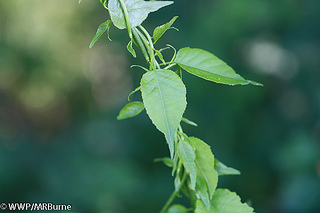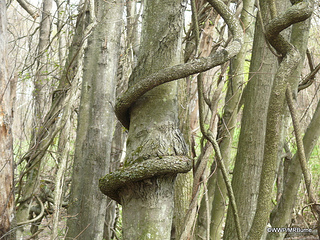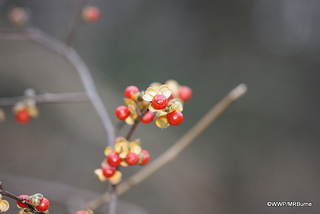Oriental Bittersweet
(Celastrus orbiculatus)
Family: Staff-tree family (Celastraceae)
Native Range: China, East Asia, Japan, Korea
 Overview: Deciduous woody perennial plant which grows as a climbing vine and a trailing shrub.
Overview: Deciduous woody perennial plant which grows as a climbing vine and a trailing shrub.
Size: Mature plants can attain stem widths of 4 inches in diameter and grow as high as 60 feet into trees.
Leaves: Alternate, glossy, nearly as wide as they are long (round), with finely toothed margins. There are separate female (fruiting) and male (non-fruiting) plants.
Stem/Bark: Green when young (new growth), maturing to tan. Climb for support, lack tendrils, and have obvious lenticels (raised pores). Bark is tannish and furrowed
Flowers: Small and greenish, blooms in May-June. Male and female flowers usually occur on separate plants. Flowers grow among the leaves at leaf axils (in contrast to native bittersweet’s flowers/fruit, which are found only at twig tips).
Seed/Fruit: Three-valved, yellow, globular capsules that at maturity split open to reveal three red-orange, fleshy arils with each containing one or two seeds. Seeds are viable for years. Because of the abundance of showy fruits, oriental bittersweet has been extremely popular for use in floral arrangements.
Roots: Orange. Will produce suckers if cut. Mostly run laterally a couple inches under the soil.
Reproduction: By seed and via the lengthy root system, which will form new stems.
Ecological Threat
- Smothers vegetation, including mature trees, which may die from excessive shading or breakage.
- Increased risk of encapsulated trees uprooting and blow-over during high winds and heavy snowfalls.
- Displacing our native American bittersweet through competition and hybridization.
Background and Distribution
Oriental bittersweet was first introduced into the U.S. in the 1860s as an ornamental plant. The species is widely spread throughout the northeast from Maine to North Carolina, and westward to Minnesota. Learn more about its range regionally and within Massachusetts.
Habitat Type
Oriental bittersweet infests forest edges, woodlands, fields, hedgerows, coastal areas and salt marsh edges, particularly those suffering some form of land disturbance. While often found in more open, sunny sites, its tolerance for shade allows oriental bittersweet to invade forested areas and persist for a long time in shaded conditions.
Management Options
 A combination of cutting followed by application of concentrated systemic herbicide to rooted, living cut surfaces is an effective approach for removing Oriental bittersweet. For large infestations spanning extensive areas of ground, a foliar herbicide is recommended over manual or mechanical methods, which would create soil disturbance, to minimize soil disturbance.
A combination of cutting followed by application of concentrated systemic herbicide to rooted, living cut surfaces is an effective approach for removing Oriental bittersweet. For large infestations spanning extensive areas of ground, a foliar herbicide is recommended over manual or mechanical methods, which would create soil disturbance, to minimize soil disturbance.
Biological Control
- None currently available.
Manual Control
- Seedlings can be pulled by hand
- Roots run laterally under the soil and be carefully dug out
- If roots are removed this can be effective but is time consuming
Mechanical Control
- To save the tree cut climbing vines near the ground and shoulder height. This will not kill the roots. If it is a new infestation repeat cutting every few weeks may be effective.
Chemical Control
- Systemic herbicides like triclopyr (such as Garlon® 3A and Garlon® 4) and glyphosate (such as Accord®, Glypro®, Rodeo®) are the most effective method to kill the plant. If native grasses are intermingled, triclopyr will not harm grasses.
- It responds well to the cut and paint method.
- Fall and winter applications avoid or minimize impacts to native plants and animals. Repeated treatments will be required.
Notice: Mention Of Pesticide Products On This Web Site Does Not Constitute Endorsement Of Any Material. See Control and Disposal Methods for descriptions of application types and warnings.
Disposal
- Leave cut vines in trees to prevent further damage to the tree
- Allow plant to dry out and desiccate then put in an invasive compost pile
Look-alikes
 American bittersweet (Celastrus scandens), which is becoming scarce in the wild.
American bittersweet (Celastrus scandens), which is becoming scarce in the wild.
Flowers (and fruits): single terminal panicles at the tips of the stems; clusters are about as long as the leaves;
Leaves: nearly twice as long as wide and are tapered at each end.
Comparing the two, American bittersweet has fewer, larger clusters of fruits whereas Oriental bittersweet is a prolific fruiter with lots and lots of fruit clusters emerging at many points along the stem. Unfortunately, hybrids of the two occur which can make identification more difficult.
Alternative Plants (Alternate Native Species)
Many attractive native vines are available that provide nectar, seed and host plant material for butterflies, hummingbirds, and other wildlife. Some examples for the eastern United States include:
- Virgin’s bower (Clematis virginiana)
- Trumpet honeysuckle (Lonicera sempervirens)
Whenever possible, use as alternatives plant species that are native and adapted to the ecological region where you live. They will be more valuable to the wildlife species that have evolved with them and depend upon them for food and shelter. Check with your local native plant society for recommendations and sources of native plants.